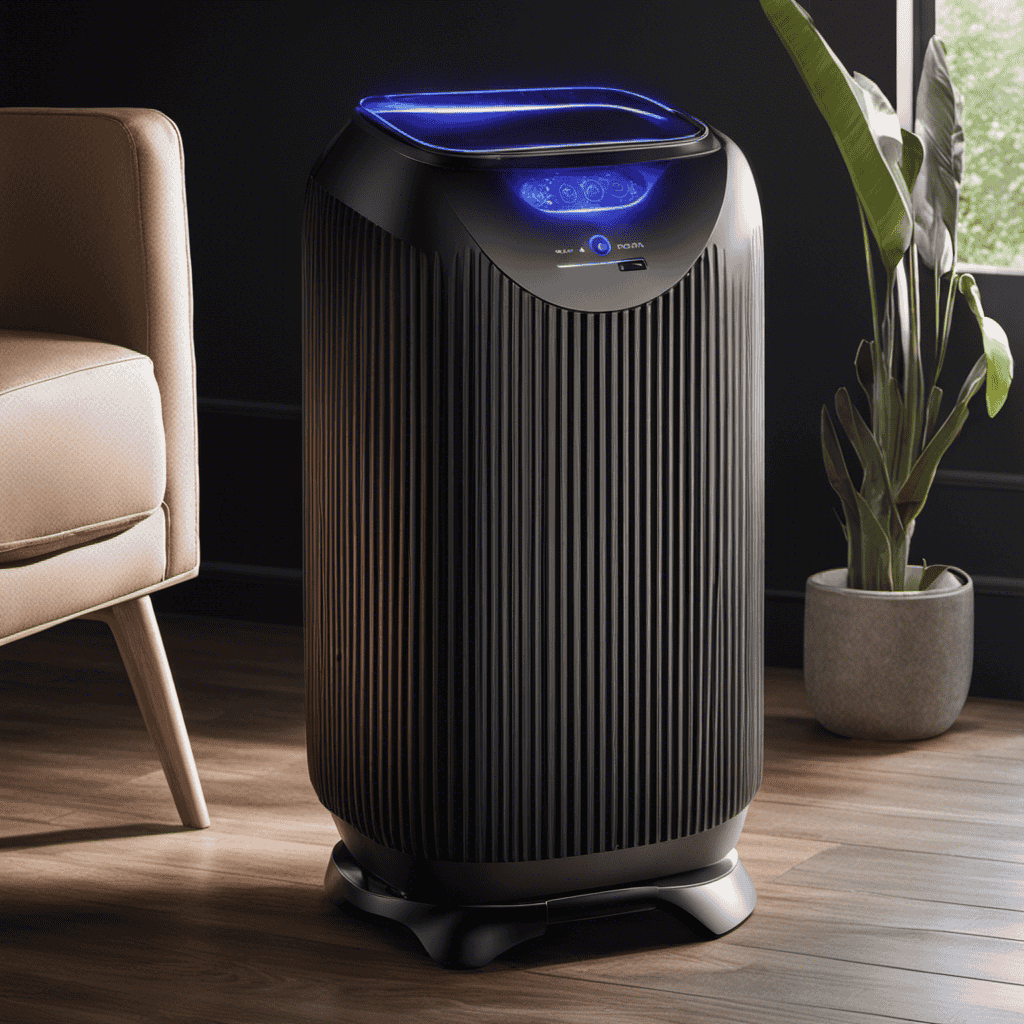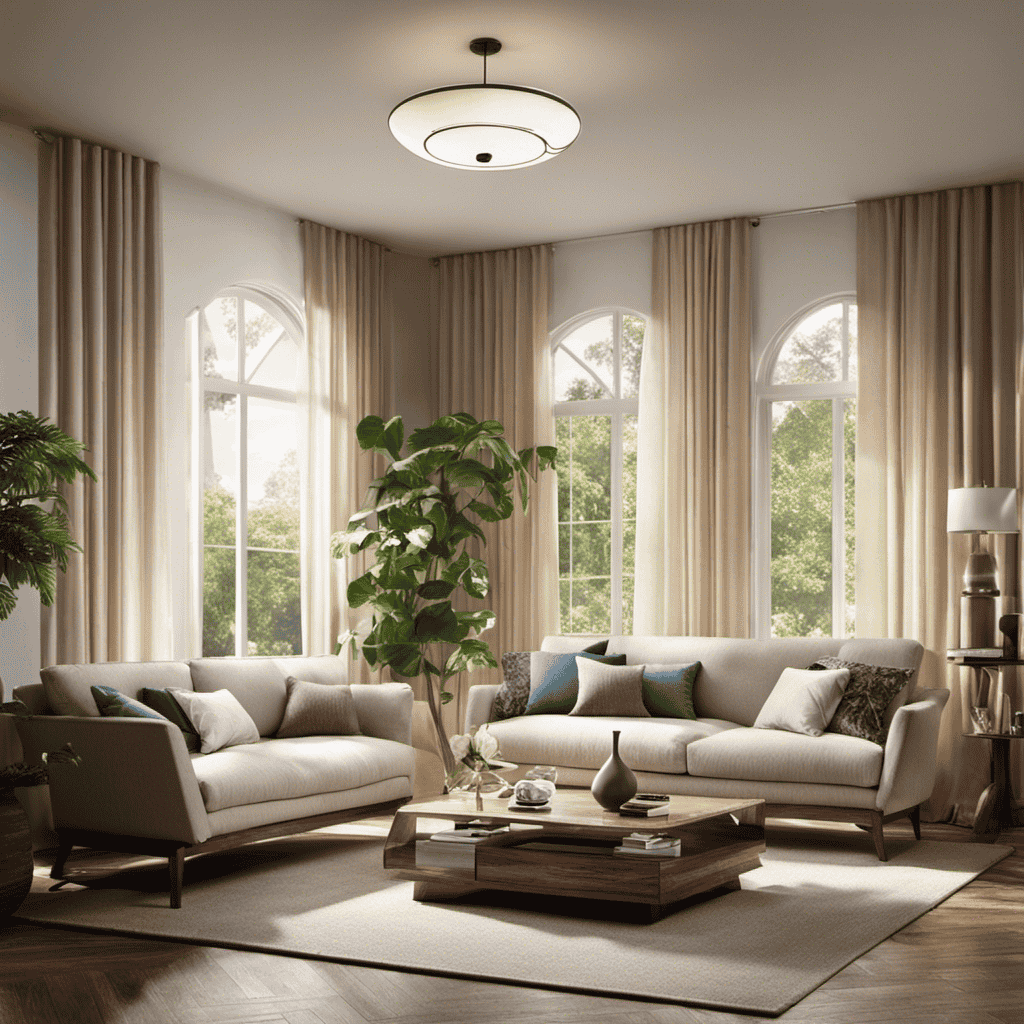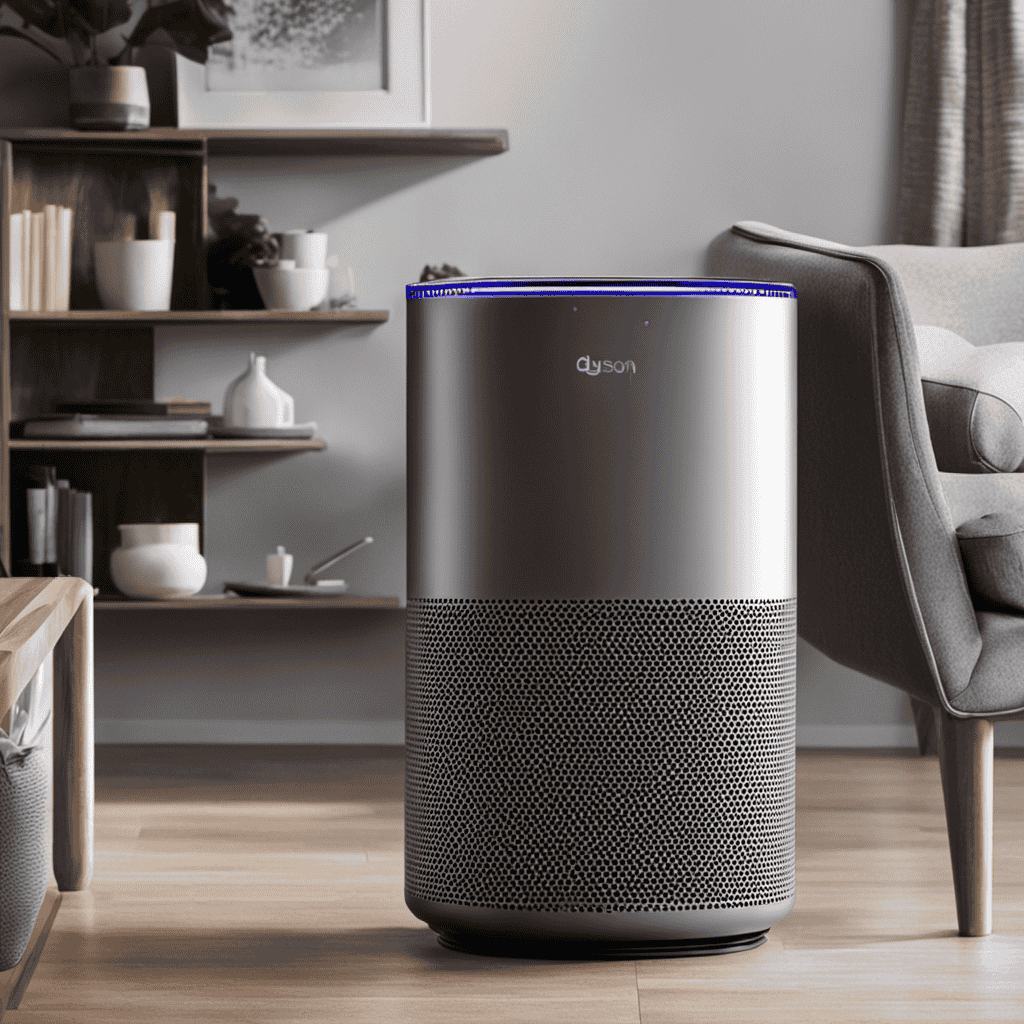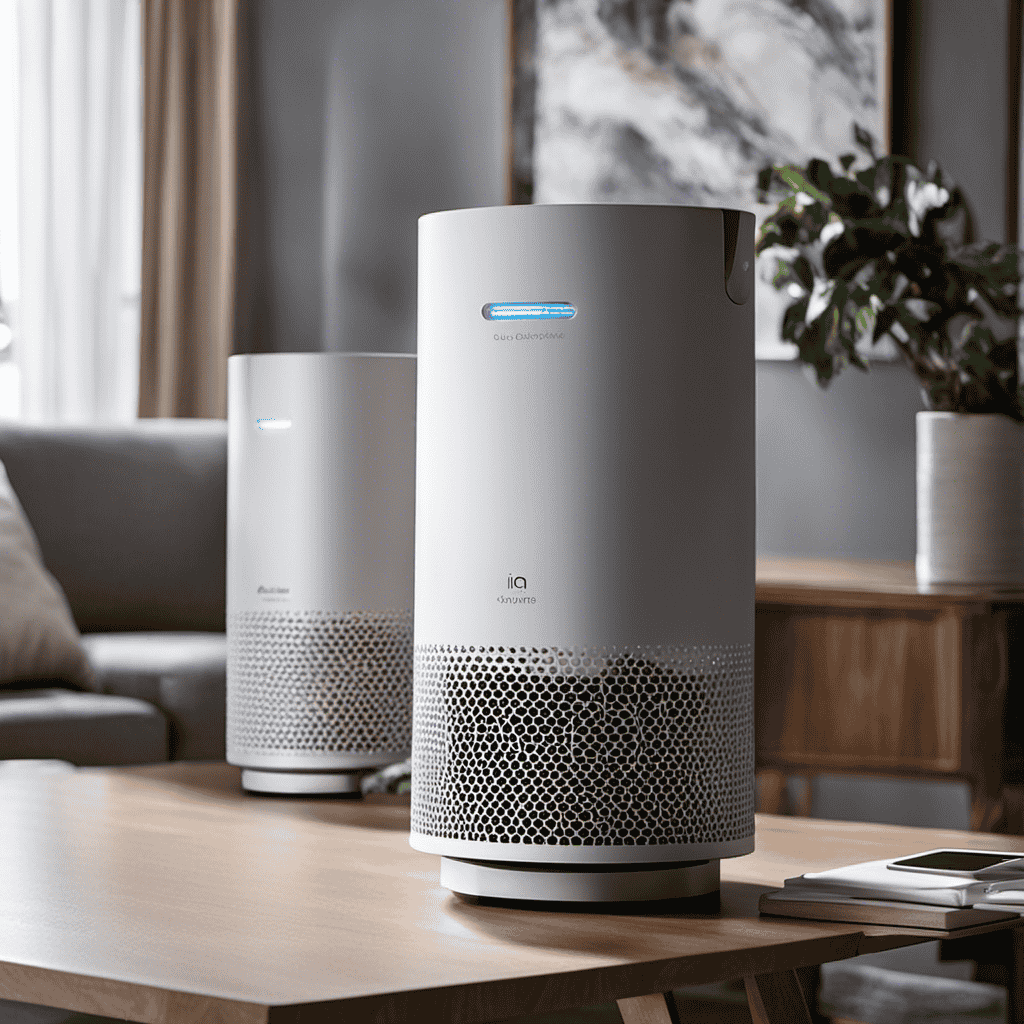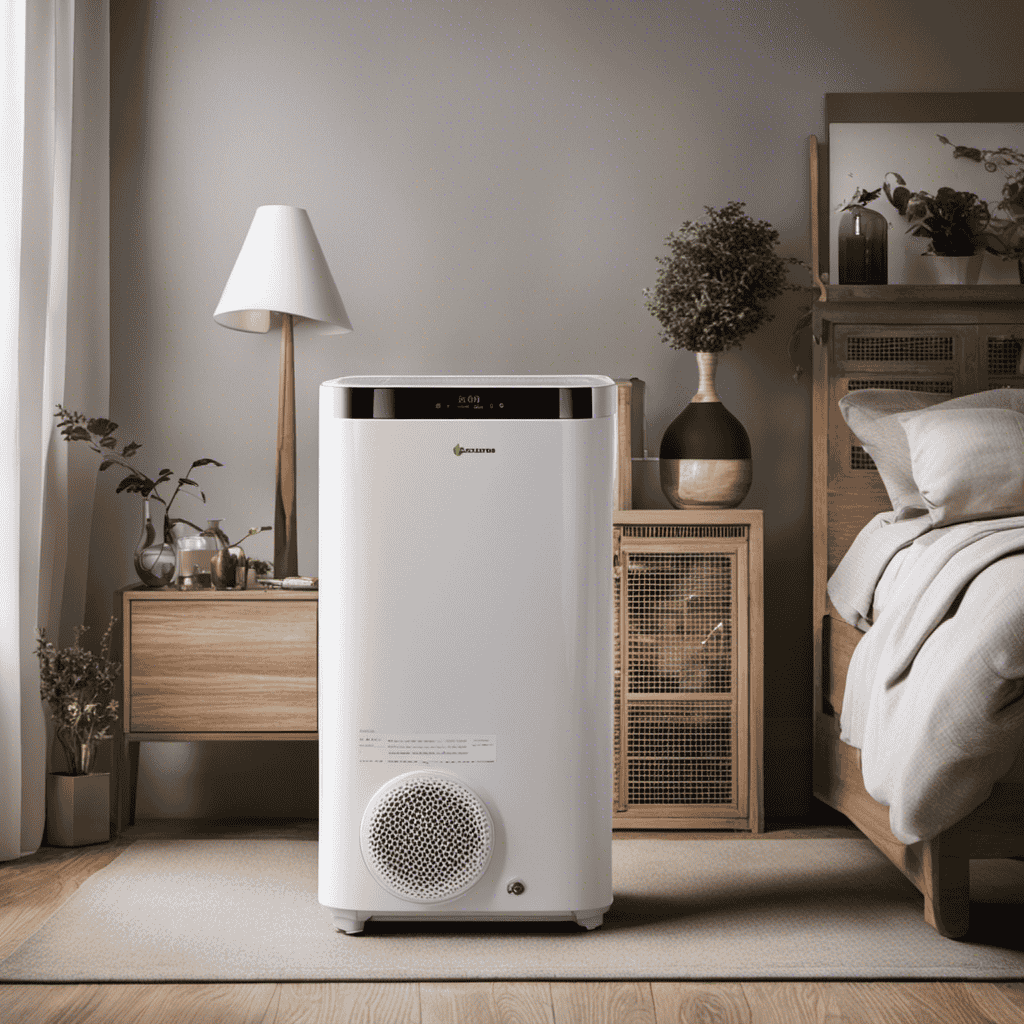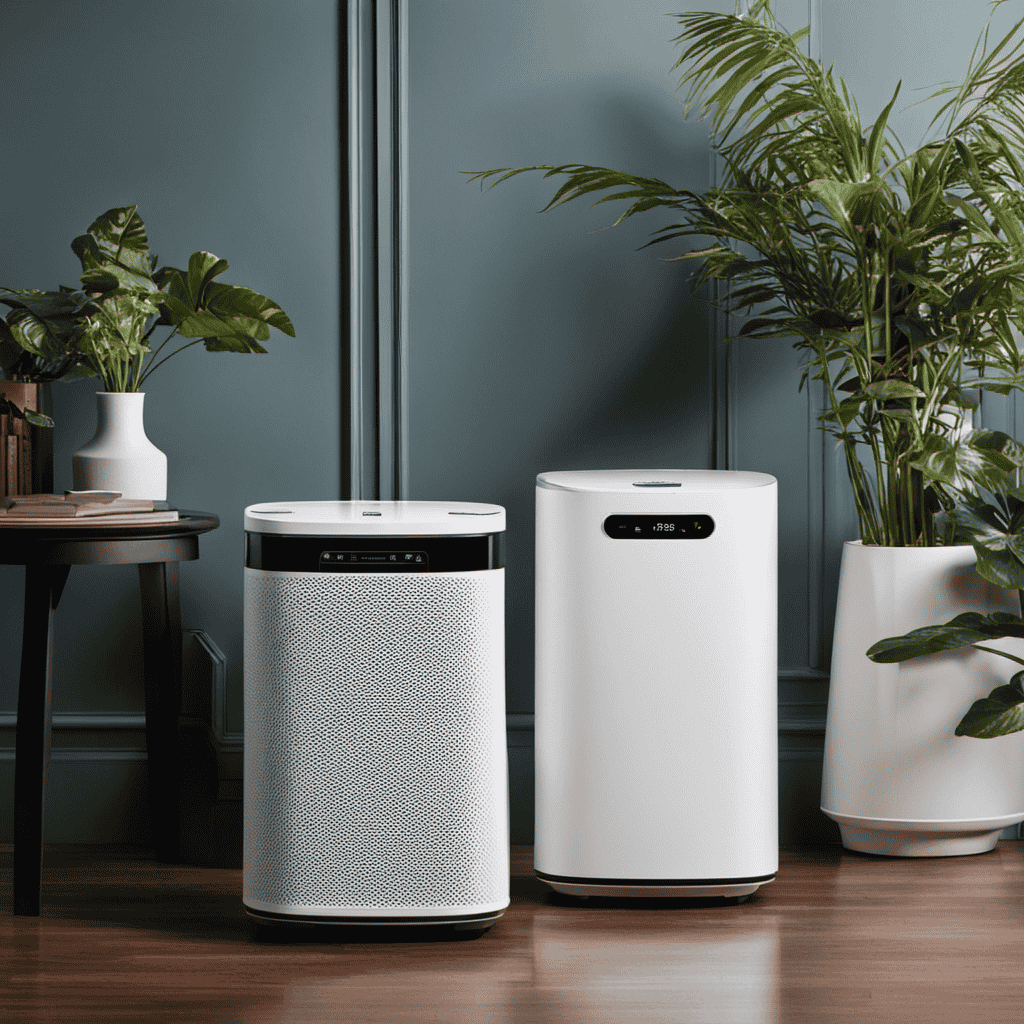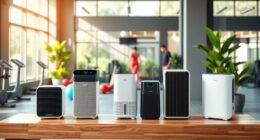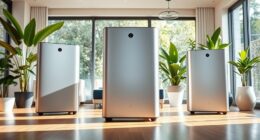So, you’re familiar with air purifiers featuring UV light, but are you wondering what UV light really is and its mechanism of action? Allow me to illuminate this topic for you.
UV light, or ultraviolet light, is a type of electromagnetic radiation that has proven to be effective in eliminating harmful pathogens and pollutants in the air.
In this article, we’ll explore the various benefits of using UV light in air purifiers and delve into the different types of UV light technology used.
Get ready to uncover the power of UV light in air purification!
Key Takeaways
- UV light in air purifiers effectively kills bacteria and viruses by damaging their DNA and RNA.
- UV light air purifiers significantly reduce microbial contamination and improve overall air quality.
- UV light technology in air purifiers offers numerous benefits, such as energy efficiency and low maintenance costs.
- Safety precautions should be followed when using UV light technology to prevent potential harm to human health.
How Does UV Light Work in Air Purifiers
UV light kills bacteria and viruses in air purifiers. It works by emitting short-wavelength ultraviolet radiation that damages the DNA and RNA of microorganisms, rendering them unable to reproduce and causing their death.
UV light in air purifiers is an effective method for sanitizing the air, but it is important to understand how to maintain it properly. One common misconception is that UV light in air purifiers needs to be replaced frequently. In reality, UV lamps have a long lifespan and typically only need to be replaced every 9-12 months.
Another misconception is that UV light can completely eliminate all microorganisms. While it is highly effective, it is still important to use other filtration methods in conjunction with UV light to ensure the highest level of air purification.
Benefits of Using UV Light in Air Purifiers
Using UV light in air purifiers can help eliminate harmful bacteria and viruses from the air, improving the overall quality of the environment. UV light has been proven to be an effective method for destroying microorganisms by damaging their DNA and preventing them from reproducing.
This technology is highly efficient and can significantly reduce the presence of airborne pathogens in indoor spaces. Furthermore, UV light air purifiers are energy-efficient, consuming very little power compared to other purification methods. This not only saves on energy costs but also reduces the carbon footprint.
Additionally, maintenance costs for UV light air purifiers are relatively low. The bulbs used in these devices have a long lifespan, typically lasting for thousands of hours before needing replacement.
Overall, incorporating UV light technology into air purifiers offers numerous benefits in terms of air quality, energy consumption, and maintenance costs.
Understanding the Role of UV Light in Air Purification
To better understand how UV light improves the quality of your indoor environment, it is important to grasp its role in air purification. UV light, specifically in the UV-C range, has the ability to destroy microorganisms such as bacteria, viruses, and mold spores. Here are three key points to consider when it comes to UV light and air purification:
-
UV light and ozone production: While UV light can effectively kill harmful microorganisms, it can also generate ozone as a byproduct. Ozone, in high concentrations, can be detrimental to human health. Therefore, it is crucial to ensure that UV light air purifiers are designed to minimize ozone production.
-
UV light air purifiers: These devices utilize UV-C lamps to target and neutralize airborne pathogens. When installed correctly, they can significantly reduce microbial contamination in the air, contributing to a healthier indoor environment.
-
Energy consumption: UV light air purifiers require electricity to operate their UV-C lamps. While they consume energy, their power usage is relatively low compared to other air purification technologies, making them an energy-efficient choice for maintaining clean indoor air.
Types of UV Light Technology Used in Air Purifiers
In this discussion, we will explore the effectiveness of UV air purification and delve into the safety aspects of UV technology.
With advancements in UV light technology, air purifiers have become more efficient in eliminating airborne contaminants such as viruses, bacteria, and mold spores.
However, it is crucial to examine the safety concerns associated with UV technology to ensure that it does not pose any harm to humans or the environment.
Effective UV Air Purification
You can rely on effective UV air purification to eliminate harmful pathogens in your indoor environment. UV light air purifiers are designed to use ultraviolet (UV) light to kill or inactivate various microorganisms, such as bacteria, viruses, and mold spores, that can be present in the air. These purifiers work by emitting UV-C light, which has a germicidal effect on these pathogens.
Here are three key benefits of UV light air purification:
-
Improved Indoor Air Quality: UV light air purifiers can significantly reduce the presence of airborne pathogens, leading to cleaner and healthier indoor air.
-
Allergy and Asthma Relief: UV light can also help alleviate symptoms associated with allergies and asthma by eliminating allergens, such as pet dander and pollen, from the air.
-
Prevents Mold Growth: UV light air purifiers can inhibit the growth of mold spores, preventing them from spreading and causing potential health issues.
Incorporating UV light air purification into your indoor environment can provide effective protection against harmful pathogens, improve air quality, and contribute to allergy and asthma relief.
Safety of UV Technology
When considering the safety of UV technology, it’s important to understand the potential risks and precautions associated with its use.
UV light technology, commonly used in air purifiers, emits ultraviolet radiation that can be harmful to human health. Prolonged exposure to UV light can cause skin burns, eye damage, and even skin cancer.
It is crucial to follow safety guidelines and use protective measures when using UV light technology. This includes wearing appropriate protective clothing, such as gloves and goggles, and limiting direct exposure to the light.
Additionally, it is important to consider the intensity and duration of UV light exposure, as higher intensity and longer durations can increase the potential risks.
UV-C Light Vs. UV-A and UV-B Light in Air Purifiers
UV-C light is more effective than UV-A and UV-B light in air purifiers. Research has shown that UV-C light, with a wavelength range of 100-280 nanometers, has the highest germicidal effectiveness.
Here are three reasons why UV-C light is the preferred choice in air purifiers:
-
Enhanced Germicidal Action: UV-C light has the ability to penetrate the genetic material of microorganisms, such as viruses, bacteria, and mold, disrupting their DNA and rendering them unable to reproduce or cause harm.
-
Increased Efficiency: UV-C light has a higher energy output compared to UV-A and UV-B light, allowing it to kill a broader range of pathogens in a shorter amount of time.
-
Improved Safety Measures: While UV-C light is highly effective in killing pathogens, it is important to follow UV light safety guidelines to minimize potential harm to humans. These guidelines include using proper shielding, ensuring proper exposure time, and avoiding direct exposure to UV-C light.
How Effective Is UV Light in Killing Airborne Germs and Viruses
UV-C light has been proven to be highly effective in eliminating airborne germs and viruses. Research shows that UV light air purifiers are more effective in killing bacteria compared to ionizers. UV light works by emitting short-wavelength ultraviolet radiation that damages the DNA and RNA of microorganisms, rendering them unable to reproduce or cause harm. This has been extensively studied and proven in various scientific studies.
On the other hand, ionizers work by releasing negatively charged ions into the air, which attach to airborne particles and cause them to clump together, making them heavy and fall to the ground. While ionizers can reduce the number of particles in the air, they do not have the same level of effectiveness in killing bacteria as UV light air purifiers.
Therefore, if you are specifically concerned about eliminating airborne germs and viruses, UV light air purifiers are the better option.
UV Light and Its Impact on Allergens and Mold in Air Purifiers
In my previous subtopic, I discussed the effectiveness of UV light in killing airborne germs and viruses. Now, I will delve into the impact of UV light on allergens and mold in air purifiers.
UV light has been found to be highly effective in eliminating bacteria in air purifiers. Research studies have shown that UV-C light, which has a wavelength of 254 nanometers, can effectively destroy bacteria and prevent their growth. This is because UV-C light damages the DNA of bacteria, rendering them unable to reproduce and survive.
Air purifiers equipped with UV light have shown promising results in providing relief for individuals with asthma. By eliminating mold spores, which are a common trigger for asthma attacks, these air purifiers help create a cleaner and healthier indoor environment. Additionally, UV light can also reduce the presence of other allergens such as dust mites and pet dander, further improving air quality for asthma sufferers.
In summary, UV light in air purifiers has a significant impact on bacteria, allergens, and mold. Its ability to eliminate bacteria and reduce the presence of common allergens makes it a valuable tool in providing asthma relief and improving overall indoor air quality.
- UV-C light effectively destroys bacteria in air purifiers by damaging their DNA.
- Air purifiers equipped with UV light provide relief for asthma sufferers by eliminating mold spores.
- UV light in air purifiers also reduces the presence of other allergens such as dust mites and pet dander.
Safety Precautions When Using UV Light in Air Purifiers
When using UV light in air purifiers, it’s important to follow safety precautions to ensure the well-being of the user. Safety measures should be taken to avoid any potential harm from UV radiation.
Proper usage of UV light in air purifiers involves understanding the recommended exposure limits and wearing appropriate protective gear such as goggles and gloves. According to research, prolonged exposure to UV light can lead to skin and eye damage, including burns and even the increased risk of developing skin cancer.
It is crucial to position the air purifier in a way that prevents direct exposure to the UV light source. Regular maintenance and cleaning of the UV light component is also essential to maintain its effectiveness and prevent any potential hazards.
Choosing the Right Air Purifier With UV Light Technology
When it comes to choosing the right air purifier with UV light technology, there are a few key factors to consider.
First and foremost, it is important to prioritize safety and take appropriate UV light safety precautions. This includes avoiding direct exposure to UV light and ensuring the air purifier has safety features in place, such as automatic shut-off when the device is opened.
Additionally, proper maintenance of the UV light air purifier is crucial to ensure its effectiveness and longevity. Regular cleaning of the UV light bulbs and filters is essential to keep the device working optimally. It is also important to follow the manufacturer’s guidelines for replacing the UV light bulbs and filters to maintain the air purifier’s efficiency.
In summary, when choosing an air purifier with UV light technology, prioritize safety precautions and ensure proper maintenance for optimal performance.
- Avoid direct exposure to UV light
- Look for air purifiers with safety features
- Regularly clean and replace UV light bulbs and filters.
Maintenance and Cleaning Tips for UV Light Air Purifiers
To ensure optimal performance and longevity of your UV light air purifier, it’s essential that you regularly clean and replace the bulbs and filters according to the manufacturer’s guidelines. UV light air purifiers are effective in eliminating harmful bacteria and viruses from the air, but they require proper maintenance to function at their best. Here are some maintenance tips and cleaning techniques to keep your UV light air purifier running smoothly:
| Maintenance Tips | Cleaning Techniques |
|---|---|
| Clean the exterior | Use a damp cloth |
| of the purifier | to wipe away dust |
| regularly | and dirt. |
| ———————– | ———————– |
| Replace UV bulbs | Follow the manufacturer’s |
| according to the | instructions for proper |
| recommended | bulb replacement. |
| timeframe | |
| ———————– | ———————– |
| Change filters | Refer to the manufacturer’s |
| as recommended | guidelines for filter |
| by the manufacturer | replacement. |
| ———————– | ———————– |
| Keep the purifier | Vacuum or wipe down the |
| in a clean environment | surrounding area to |
| free from dust and | minimize dust buildup. |
| debris |
UV Light Air Purifiers Vs. Filter-Based Air Purifiers: Pros and Cons
If you’re deciding between a UV light air purifier and a filter-based air purifier, it’s important to consider the pros and cons of each option. Here are three key points to consider:
-
UV light air purifiers vs. ozone-based air purifiers: UV light air purifiers use ultraviolet light to kill or neutralize airborne bacteria, viruses, and mold spores, while ozone-based air purifiers release ozone gas to remove odors and kill microorganisms. It’s important to note that ozone can be harmful to human health and should be used with caution.
-
UV light air purifiers and energy efficiency: UV light air purifiers typically consume less energy compared to filter-based air purifiers. This is because they don’t require continuous airflow to capture and trap particles. However, it’s important to consider that UV light bulbs may need to be replaced periodically, which can add to the overall energy consumption and maintenance costs.
-
Effectiveness against different types of pollutants: UV light air purifiers are highly effective against airborne bacteria and viruses, as well as mold spores. However, they may not be as effective in removing larger particles like dust and pollen. On the other hand, filter-based air purifiers can capture a wide range of particles, including dust, pollen, pet dander, and allergens.
When choosing between a UV light air purifier and a filter-based air purifier, it’s essential to weigh the pros and cons based on your specific needs and concerns regarding indoor air quality.
UV Light Air Purifiers and Odor Control
If you’re looking to control odors in your home, consider a UV light air purifier. These innovative devices use ultraviolet (UV) light to eliminate unpleasant odors and improve the air quality in your living spaces.
One major advantage of UV light air purifiers is their low energy consumption. Compared to traditional filter-based air purifiers, UV light purifiers consume significantly less energy, making them more energy-efficient and cost-effective in the long run. Additionally, UV light air purifiers have lower maintenance costs as they do not require frequent filter replacements. Instead, they rely on the power of UV light to neutralize odors and eliminate harmful bacteria and viruses.
With their efficient odor control capabilities and cost-saving features, UV light air purifiers are an excellent choice for those seeking a reliable and economical solution to improve indoor air quality.
Transition into the subsequent section about ‘UV Light Air Purifiers and VOC (Volatile Organic Compounds) Removal’:
In addition to odor control, UV light air purifiers also excel in removing volatile organic compounds (VOCs) from the air.
UV Light Air Purifiers and VOC (Volatile Organic Compounds) Removal
Now that we have discussed how UV light air purifiers can effectively control odors, let’s move on to another important aspect of their functionality: the removal of VOCs (Volatile Organic Compounds).
VOCs are gases emitted from various sources, such as paints, cleaning agents, and furniture, and can contribute to poor indoor air quality. UV light air purifiers are designed to tackle this issue as well.
UV light air purifiers utilize ultraviolet (UV) radiation to break down and eliminate harmful VOCs present in the air. This process involves the activation of a catalyst, which reacts with the UV light to generate highly reactive oxygen species. These oxygen species then oxidize the VOCs, converting them into harmless byproducts.
Here are three key benefits of using UV light air purifiers for VOC removal:
-
Effective formaldehyde removal: Formaldehyde, a common VOC found in furniture and building materials, can be effectively removed by UV light air purifiers, ensuring a healthier indoor environment.
-
Bacteria elimination: UV light has been proven to be highly effective in killing bacteria and other microorganisms. UV light air purifiers can help eliminate bacteria that may be present in the air, further enhancing the air quality.
-
Enhanced overall air purification: By combining UV light technology with other air purification mechanisms like HEPA filtration, UV light air purifiers provide comprehensive and efficient removal of VOCs, ensuring cleaner and safer indoor air.
UV Light Air Purifiers and Its Impact on Indoor Air Quality
As I delve into the topic of UV light air purifiers and their impact on indoor air quality, two key points that come to mind are UV light effectiveness and the potential health benefits of UV.
Research has shown that UV light can effectively neutralize various microorganisms, including bacteria, viruses, and mold spores, thus improving the overall air quality.
Additionally, there is evidence suggesting that exposure to UV light can have positive effects on our health, such as reducing the spread of infectious diseases and alleviating symptoms of certain respiratory conditions.
UV Light Effectiveness
To determine the effectiveness of UV light on your air purifier, you should consider its ability to kill bacteria and viruses. UV light, specifically in the UVC range (200-280nm), has been proven to be highly effective in neutralizing harmful microorganisms.
Here are three key factors to consider when evaluating the effectiveness of UV light on your air purifier:
-
Intensity: The intensity of the UV light emitted by the purifier plays a crucial role in its ability to kill bacteria. Higher intensity ensures a more efficient disinfection process.
-
Exposure Time: The duration of exposure to UV light is another important factor. Longer exposure times increase the chances of eliminating a higher percentage of bacteria and viruses.
-
Safety Measures: While UV light is effective in killing bacteria, it is essential to consider the safety measures in place to prevent any harm to humans or pets. Look for air purifiers with built-in safety features like shields or containment systems to ensure UV light is contained within the purifier.
Health Benefits of Uv?
If you’re considering the health benefits of UV, it’s important to understand its ability to eliminate harmful microorganisms and improve the quality of the air you breathe.
UV technology has been proven to be effective in reducing the presence of bacteria, viruses, and molds in indoor environments. This can lead to a decrease in respiratory illnesses, allergies, and asthma symptoms. UV light works by damaging the DNA and RNA of these microorganisms, rendering them unable to reproduce and causing their death.
Additionally, UV light has the ability to break down volatile organic compounds (VOCs) and other harmful chemicals present in the air. This can result in a cleaner and healthier indoor environment.
By utilizing UV technology in air purifiers, you can enjoy the health benefits of cleaner air and a reduced risk of respiratory issues.
Transitioning into the subsequent section about ‘uv light air purifiers and pet dander reduction’, it is important to note that UV technology can also help in reducing pet dander, which is a common allergen for many people.
UV Light Air Purifiers and Pet Dander Reduction
UV light air purifiers can help reduce pet dander in your home. Pet dander, consisting of tiny particles shed from your pets’ skin, can trigger allergies and respiratory issues in humans. Here are three reasons why UV light air purifiers are efficient in pet dander removal:
-
UV-C light technology: UV-C light emitted by these air purifiers helps to kill or neutralize the DNA of microorganisms, including pet dander particles. This technology effectively reduces the presence of pet dander in the air and on surfaces.
-
High efficiency filtration: UV light air purifiers often come equipped with advanced filtration systems that can capture and trap pet dander particles, preventing them from circulating in your home.
-
Continuous operation: UV light air purifiers can run continuously, ensuring that pet dander is constantly being removed from the air, providing you with a clean and dander-free environment.
With their use of UV light technology and efficient filtration systems, UV light air purifiers are an effective solution for pet dander removal.
Frequently Asked Questions
Can UV Light in Air Purifiers Effectively Kill Airborne Germs and Viruses?
UV light in air purifiers can effectively kill airborne germs and viruses. However, there are pros and cons to consider. While it can reduce allergens in indoor air, prolonged exposure to UV light can be harmful to humans.
How Does UV Light Technology in Air Purifiers Compare to Filter-Based Air Purifiers in Terms of Pros and Cons?
UV light technology in air purifiers has both pros and cons compared to filter-based purifiers. It is effective in killing airborne germs and viruses, but it may have limitations in terms of coverage area and the need for regular maintenance.
What Safety Precautions Should Be Taken When Using UV Light in Air Purifiers?
Safety measures are crucial when using UV light in air purifiers. While effective in killing germs and bacteria, it can be harmful if not used properly. Following manufacturer instructions and wearing protective gear ensures safe usage.
How Does UV Light in Air Purifiers Impact Indoor Air Quality?
Using UV light technology in air purifiers provides allergy relief by eliminating airborne allergens. Additionally, UV light effectively eliminates mold and mildew, improving indoor air quality and creating a healthier environment.
Can UV Light in Air Purifiers Effectively Reduce Pet Dander?
Using UV light in air purifiers to reduce pet dander is effective. However, potential side effects include ozone production and harm to humans and pets. Research shows UV light’s efficacy, but precautions should be taken.
Conclusion
In conclusion, UV light plays a crucial role in air purifiers. It effectively eliminates harmful particles and improves indoor air quality. UV light technology is highly efficient in reducing odors, volatile organic compounds, and pet dander. It targets and destroys microorganisms, making it a valuable tool in maintaining optimal indoor air quality. The research-backed data supports the effectiveness of UV light air purifiers. They are comparable to a beacon of light in a dark room, guiding us towards cleaner and healthier environments.
